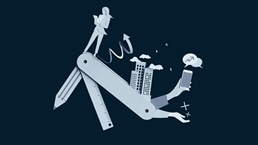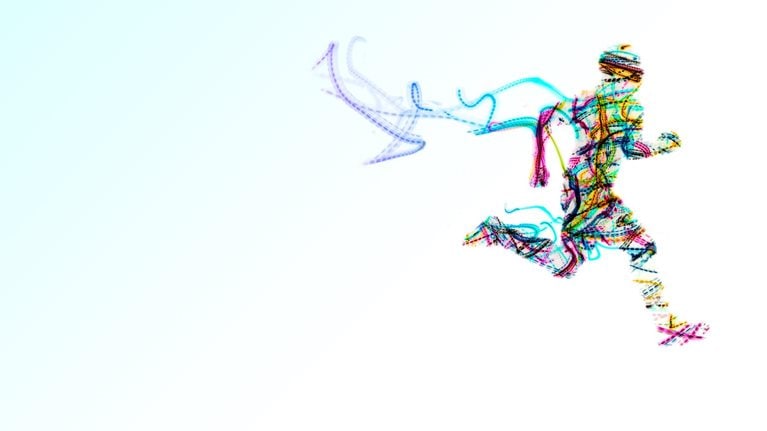Often in business, the biggest breakthroughs come when organizations connect different, and seemingly disparate, ideas and approaches. Diversity of perspective has been shown time and again to foster fresh thinking to solve tough problems. Such is the promise for organizations that can effectively bring together data and design.
Stay current on your favorite topics
Data are often prized for their indifference to intuition, stoic reflection of the facts, and ability to shatter our assumptions—veritable superpowers when put into the hands of decision makers. While data have always been an important business input, recent advances in artificial intelligence (AI) and other analytics are only increasing the number of organizational arenas in which decision makers can activate data’s superpowers, from hiring to product development to customer engagement.
Separately, design thinking has spread like wildfire across industries after some iconic brands and born-digital companies (think Apple and Google) demonstrated the revenues and customer satisfaction it could drive. Harnessing qualitative insights, creativity, and a relentless focus on end-user needs, the approach is typically aimed at product and service innovation.
Yet, while organizations are increasingly reaping the rewards of data and design, we find that many are missing out on the benefits they offer when used in combination. Simply hiring both designers and data professionals to perform their discrete functions (even when on the same project) isn’t enough. Organizations need to enable the two to effectively work in lockstep—so that the whole is greater than the sum of its parts. Getting this interplay right unleashes the ability not only to create killer, user-centric products and services but also, as we illustrate throughout this article, to improve business processes, an area in which the combination of data and design is greatly underutilized by many organizations today. In fact, we’ve seen, on average, a 10 to 30 percent performance improvement among companies that tightly interweave data and design capabilities to solve business problems far removed from product innovation but undeniably critical to the organization’s success.
But how do companies knit data and design together more effectively? Three key shifts are required: moving from silos to squads, from disconnected workflows to deep synchronicity of skills, and from product innovation only to operations-wide use.
From silos to squads
In a study of the design practices of 300 companies, we found that the top financial performers had integrated design across the organization rather than creating design units within specific departments, such as marketing or customer service, or within discrete functions, such as customer experience management (exhibit).

In our experience, the most effective integration of design is through the assembly of “squads” that include both data experts (data scientists, data engineers, and so on) and designers (design researchers, visual designers, and others) who are seated side by side—preferably physically in the same workspace. Wherever data and analytics capabilities reside—in a center of excellence serving the enterprise, embedded within the business units themselves, or both—design capabilities should reside as well. While their “straight-line” manager may be within their own field (for example, design reports to a design lead and data experts report to an analytics lead), all squad members should have a “dotted-line” reporting relationship with the squad leader responsible for solving a particular business problem and take their direction on a daily basis from him or her. These squads act as the first responders when it comes to understanding a business problem, identifying and prioritizing potential solutions, and developing the business case and prototypes. Once an organization is ready to build and implement a solution, these squads can easily be integrated into an agile-development team to help bring the solution to life. One McKinsey research study found that 60 percent of companies successfully scaling analytics to solve problems across the organization used cross-functional teams.
Through these squads, teams can achieve a more iterative inquiry process and combine the best of both worlds: deep qualitative insights around motivations, attitudes, and business processes, and strong quantitative insights from data. A data expert might see a pattern emerging in the data and can ask his or her teammates in design to probe end users on the subject during their ethnographic interviews. Design teams might hear an interesting point of view during an interview with an end user and ask their data colleagues to explore whether the belief is unique to the participant or reflects a larger pattern that they need to explore.
Would you like to learn more about McKinsey Analytics?
At one bank, placing data and design on the same team drove the discovery of an issue that wasn’t on its radar: customers were visiting branches with the sole purpose of checking account balances, consuming tens of thousands of hours in tellers’ time and taking them away from relationship-building activities. As the team explored key issues affecting the customer experience, a data scientist noticed this unexpected pattern in the data, which on its own could have been dismissed as a “data-set problem,” given it contradicted widely held beliefs on how customers obtained balance information.
Instead, the data expert called his design colleagues in the field to validate this finding. With feedback in hand from design verifying this surprising trend among customers, the team dug in to understand the full scope of the problem and, ultimately, expanded its business case to move these basic interactions to online-banking and interactive-voice-response (IVR) channels.
In forming these squads, forward-thinking organizations go beyond the creation of cross-functional teams. They also facilitate the development of cross-functional knowledge by training their data scientists to understand (and appreciate) how design research is done and the value it brings, and, conversely, enabling designers to gain an inside view of the work of data scientists and better realize how data can be harnessed. Such knowledge building can occur through formal workshops or via on-the-job training. One large pharmaceutical company working to identify what partnerships and services would help improve the patient experience associated with one of its products across multiple geographies used teaching sessions so that team members—which included data scientists, designers, market researchers, and business experts—could understand the methodologies data and design experts used. These teaching sessions enabled data and design experts to share the pros and cons of different methodologies in their respective fields, while shadowing exercises gave team members a front-row seat to see the value of data and design in action.
From disconnected to deep synchronicity
Frequently when data and design are thought to be “working together,” their efforts proceed in relay-race fashion, with each team passing off the baton to the next once its “lap” is completed. Design researchers and visual designers are called upon at predictable and distinct junctures within a project life cycle to offer a user-centric perspective—for example, to perform ethnographic interviews or design a user interface. They’re on the scene for a few weeks and then head to their next project once they complete their reports and submit their recommendations to data teams.
However, this relay-race dynamic among data and design hampers efforts to evaluate a business challenge in a larger context, a framing that provides fertile ground for developing truly novel solutions. Early-20th-century architect Eliel Saarinen’s advice to “always design a thing by considering it in its next larger context—a chair in a room, a room in a house, a house in an environment, an environment in a city plan” offers guidance to understand what this larger context looks like. To solve a specific business challenge—whether it’s around product innovation, digital transformation, or operational efficiency— teams need to understand how the challenge sits within a process and how that process fits within the organization, which operates in an industry and society at large.
But to broaden the line of sight, data and design must work in a more synchronized fashion, like a rowing team, where members provide equal and uninterrupted participation with each oar stroke.
Within this model, data and design experts naturally share perspectives and actively apply their skills across all facets of the project life cycle. For example, within agile-development processes, a close-knit data and design effort can help teams leapfrog past well-worn assumptions to unearth deployment and data challenges and surface end-user needs. It’s this constant intermingling of ideas and expertise throughout the project that illuminates these intricate relationships to vastly improve business results and enable teams to course-correct as needed once development is underway.
One auto manufacturer’s work to improve its production process demonstrates the power of closely woven design and data methods. As the manufacturer sought to uncover the cause of production delays, the fusion of data and design enabled it to view the problem with a wider lens. Had designers not been involved or had they worked separately from data experts, the organization likely would have looked at the problem through a very narrow prism. Calling in designers solely to conduct qualitative interviews of supply-chain staff or asking data experts to analyze supply-chain data would have surfaced supply-chain inefficiencies—which, while problematic, weren’t the root cause of the delays.
Instead, designers sat at the same table with data experts from the outset to expand their focus from the supply chain to a car’s entire journey, mapping out not just how each car was manufactured but also what parts went into each car. Understanding the entire journey, part by part, shifted the organization’s focus from only six departments to the end-to-end life cycle of the 14,000 parts that comprised the car. Along the way, data and design brought their diverse skills to bear in visualizing the data, which led to solving the problem in a different way and, ultimately, to a surprising discovery: production delays weren’t caused by something that had gone awry in the supply chain. The seed for the delays, it turned out, was planted much earlier. The team’s work showed that product designers were signing off on parts even though they hadn’t completed their specification drawings. Fixing this problem alone helped reduce time to market by just over 2 percent and was integral to a larger program that reduced time to market by 10 percent.
Such deep synchronicity can also help keep project delivery schedules on track. One biopharmaceutical company found this harmonized approach key to fast-tracking development of a new AI tool that could identify root causes of product-quality issues. As data engineers pulled together data from multiple sources, design was on hand to visualize how the business captured the data so that any potential inconsistencies could be caught and rectified. At one point, this helped the team uncover, in just a few days, material changes in the way the business had captured data at different points in time that otherwise could have taken data engineers weeks to discover and fix.
From product innovation only to operations-wide
Often, we find that companies turn to design only for product innovation, whether it be in product development or delivery. While companies are increasingly leveraging data to improve business processes, in our experience it’s much less often that they incorporate design into these efforts, outside of developing user interfaces. As demonstrated by several of the examples shared in this article, integrating both data and design in business-process improvement or redesign can deliver superior results.
Some of the customer-journey principles employed in product innovation can also be applied to business-to-business processes. The auto manufacturer, for example, focused on the car’s journey through production, part by part.
One large energy company’s work to increase efficiency in its operations offers a road map on how to think through such a journey—in this case, the material’s journey.

The business value of design
Small changes across a network can affect how material arrives at a plant, and business leaders wanted to give the frontline operators data-driven insights to increase production rates. Instead of simply calling on data experts to build a machine learning algorithm to recommend the best (and most cost-effective) way to configure the network, and recruiting design to help create the user experience, more than 20 people from design, data, and the business gathered in a single conference room to define the problem. Over the course of several days, they explored the entire process of how the material was extracted, how operators made their decisions, and what data and tools operators already used. The project team posted sticky notes on the conference-room walls, providing detailed insights on operator needs, challenges, and opportunities.
While business leaders were well versed in every stage of the production process, this exercise allowed them to see for the first time a big picture of how these processes were connected and who made what decisions at key junction points. This changed their focus entirely, from creating an optimization tool for ten to 20 engineers across the network to building a tool specifically for the two operators who were in charge of analyzing and making decisions for one section of the process on a daily basis.
Once tool development was underway, data and design experts jointly met with the end users to understand their thought process in routing the material across the network and what factors led them to choose one pathway over another. It led to a second aha moment: the algorithms didn’t have to think about the individual sections to travel across but instead had to consider what was the holistic route the material could take. This simplified the mathematical engine of the solution to reduce the time and cost of deployment in addition to providing an intuitive way to display the results to the operators to help increase adoption.
In the past decade, the use of data and design among businesses has skyrocketed. Born-digital companies and those that have faced significant digital disruption in their industries are much further along in merging these disciplines as a natural evolution of their culture. These companies often have fertile environments, with agile practices and multidisciplinary mind-sets that allow diverse approaches, such as the ones described in this article, to easily intermingle and ultimately flourish together.
But for the rest, conditions aren’t ripe. Institutional silos, disconnected workflows, and misconceptions of design as primarily an innovation and product-development framework hold companies back from realizing the greater value that data and design can deliver together.
Ultimately, the more data and design experts are integrated and work together, the earlier they begin working together on a project, and the wider their purview across the enterprise, the greater the reward.


